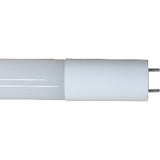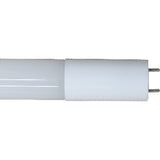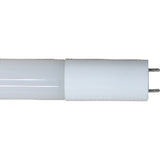LED Linear T8 Retrofits: Sorting Through The Options
Posted by Dave on for ProLampSales

One look at the LED T8 retrofit lamp and installation options can quickly make you want to run for cover - or give up and live with fluorescent.
The later approach, while not as forward-looking as LED, makes some sense especially if you are comparing the 30,000 to 40,000 hour T8 fluorescent lamps now available with 35,000 to 50,000 hour LEDs. From a low risk perspective, not to mention low up front costs, current generation fluorescent T8 systems are still in the game and should be included in the decision-making.
But this post is about the LED T8 tube retrofit alternatives and how to sort through the options:
- Ballast Compatible
- Ballast Bypass/Line Voltage - remove ballast and wire line voltage direct to sockets
- Ballast Bypass/LED Driver - remove ballast and replace with an LED driver
- Dual Mode: Ballast Compatible or Ballast Bypass/LED Driver
The U.S. Department of Energy has done a recent study of actual installations in an office environment comparing the Ballast Compatible and Ballast Bypass with LED driver options. Lighting performance, energy savings and occupant satisfaction among other factors were analyzed.
The results indicate that both of these types of retrofits provide very similar energy savings (27% - 29%) and the occupant satisfaction level was positive - the quality of the light and light levels were similar to fluorescent. Installers reported few complaints about the installation process for either approach.
While this is only a single study directly comparing two of the four possible LED T8 retrofit options, it provides an initial positive outlook for owners and contractors contemplating an LED T8 solution.
Let's look at the pros and cons of each of the four options listed above.
Ballast Compatible (UL Type A)
This is the plug-and-play option. Replace the fluorescent tube with the LED tube. Use the existing ballast and sockets.
Advantages
- Appealing for it's simplicity.
- No rewiring, the retrofit can be accomplished by maintenance staff.
- Lowest LED bulb cost.
- Lowest installation cost –the same as replacing a fluorescent T8.
Disadvantages
- Before buying the plug-and-play LED T8s, it's important to determine if the existing fluorescent ballasts are compatible with the LED bulbs. Not difficult, but an extra step. The LED T8 manufacturer should provide a ballast compatibility list.
- The ballast adds a couple of watts to the overall system energy use - lamp watts + ballast watts = system watts (exactly like fluorescent).
- When the ballast stops working, so does the LED bulb. Since the bulb is designed to operate off fluorescent ballasts, the only option is to install a new ballast.
- Future maintenance staff could re-install fluorescent tubes and short circuit the energy and maintenance savings.
Ballast Bypass Wire Line Voltage Direct to Socket (UL Type B)
This ballast bypass option removes the ballast from the system either by disabling the wiring or physically taking it out of the fixture. Line voltage (120 or 277) is then wired to at least one of the sockets. The LED tubes are designed to operate directly from line voltage.
Advantages
- Ballast energy use eliminated. System watts matches the LED lamp watts.
- No ballast maintenance.
Disadvantages
- Electrician required for the re-wiring.
- No standardized approach to re-wiring. Some manufacturers require connecting line voltage to only one socket, some to both. Some require non-shunted sockets, some shunted sockets. The electrician must take the time to carefully follow the installation instructions provided by the LED T8 manufacturer.
- Higher installation cost.
Ballast Bypass With LED Driver Replacing the Ballast (UL Type C)
This ballast bypass/LED driver option requires removing the ballast from the fixture and replacing it with an LED driver that uses line voltage inputs and wires output to the sockets.
Advantages
- More long-term reliability – current generation LED drivers have longer rated life than fluorescent ballasts and are optimized for LED lamps.
- More energy efficient than the ballast compatible approach– LED drivers do not add significant energy use to the overall system.
Disadvantages
- Higher system material cost – both an LED lamp(s) and driver must be purchased.
- Higher installation cost - requires an electrician - compared to Ballast Compatible option.
Dual Mode – Ballast Compatible and Ballast Bypass with LED Driver (UL Type A and Type B)
A few manufacturers offer this dual mode option that allows an initial plug-and-play LED T8 installation while anticipating the day when the ballast stops working by providing the possibility of replacing the ballast with an LED driver.
Advantages
- Built-in flexibility with two installation options.
Disadvantages
- Same as listed above for each of these approaches.
- DLC listing, obtained for the ballast compatible approach, may not apply if/when the ballast bypass option is implemented.
Conclusion
With current generation LED T8 products offering lower prices and improved specifications, the cost-effectiveness of retrofitting existing fluorescent fixtures, using any of the available approaches, becomes more and more attractive. The comprehensive DOE study discussed above, should also provide confidence that occupant satisfaction with an appropriate retrofit will be positive.
Featured Products (View All)
- 0 Comments
- Posted in Energy Efficiency, LED, Retrofits
0 Comments




